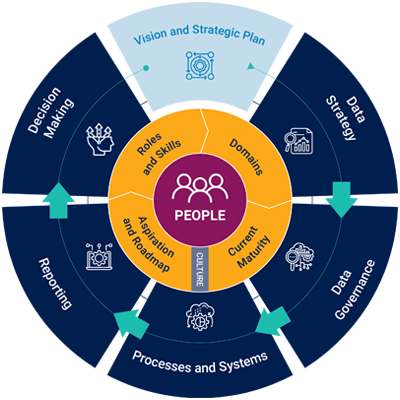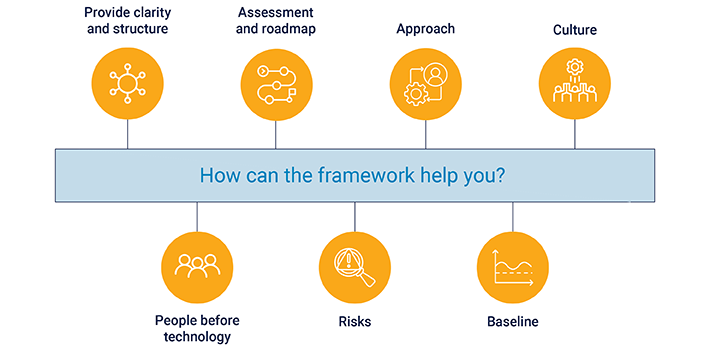Data maturity framework
The data maturity framework is in place to support you to improve your data capability – as far as that is needed by your institution, college or provider.
You may want to better understand data maturity, what it involves and what good looks like. Or you may be looking for ways to engage your colleagues as you seek time and/or investment.

The framework has been compiled with input from practitioners across the sector, utilises content previously developed and consulted on by HESA and best practice from other sectors. It will help you think about the role of people, the data journey within your university or college and how you might plan actions to improve your maturity effectively.
The framework:
- Includes definitions and information which reference data in a further and higher education context.
- Is aimed at people in data, reporting and reporting consumer roles.
- Signposts to information suitable for the challenges you may face.
Why is data maturity important?
Well-managed, accurate data is essential for the statutory and regulatory responsibilities you hold. But what role should data play beyond these?
- As your organisation seeks to do the best job it can for your students and staff, should decisions be data driven or data enabled?
- Is the role of data to validate experienced staff judgement, or to challenge established thinking and usher teams towards new approaches?
- As technology develops, how do you see new tools and practices enhancing the services you provide and the processes you manage?
- What is involved in delivering effective data management at an enterprise level?
Managing data as an asset supports the effective delivery of many key priorities.

Student engagement and wellbeing
Effective data frees up staff time for student facing activities and provides evidenced based insight to support individuals and cohorts more proactively.
Effective data frees up staff time for student facing activities and provides evidenced based insight to support individuals and cohorts more proactively.
Statutory data
The interpretation of regulatory guidance can be complex and time consuming. Improved data accuracy and availability for statutory reporting will support teams, ensuring they can focus on issues by exception rather than large scale manual cleansing.
The interpretation of regulatory guidance can be complex and time consuming. Improved data accuracy and availability for statutory reporting will support teams, ensuring they can focus on issues by exception rather than large scale manual cleansing.
Staff wellbeing
Providing the right tools for teams to do their jobs can go a long way to empowering individuals and reducing stress. Both report providers and consumers need the right software, systems and support to move away from ad-hoc delivery.
Providing the right tools for teams to do their jobs can go a long way to empowering individuals and reducing stress. Both report providers and consumers need the right software, systems and support to move away from ad-hoc delivery.
Research management
Visibility of research applications and success rates can enable more effective grant capture. Data can also help effective contract costing and management and provide insight into digital and other resource needs.
Visibility of research applications and success rates can enable more effective grant capture. Data can also help effective contract costing and management and provide insight into digital and other resource needs.
AI, machine learning and predictive analytics
Foundational processes, infrastructure and capabilities will enable providers to consider how to best utilise the opportunities of more advanced analytic solutions.
Foundational processes, infrastructure and capabilities will enable providers to consider how to best utilise the opportunities of more advanced analytic solutions.
Funding
Mature data architecture and processes support confident funding models, robust compliance and improved financial forecasting.
Mature data architecture and processes support confident funding models, robust compliance and improved financial forecasting.
League tables
Improved understanding of league table data and drivers can support providers in focusing resources on underpinning performance – to be "better" - rather than ranking gamification.
Improved understanding of league table data and drivers can support providers in focusing resources on underpinning performance – to be "better" - rather than ranking gamification.
Operational efficiencies
Established data governance and architecture, automated data processing and effective reporting all reduce risk and save staff time for value-added work across your different functions.
Established data governance and architecture, automated data processing and effective reporting all reduce risk and save staff time for value-added work across your different functions.
Why is a framework needed?
Data is an organisational asset, but is rarely managed as one.

The challenge
Low data maturity creates inefficiency that costs time and money but there's no magic bullet for data management and use.
Low data maturity creates inefficiency that costs time and money but there's no magic bullet for data management and use.
The operational impact of low maturity
- It's challenging to agree a definitive view of current performance.
- Dependencies between strategic and operational priorities may not be understood.
- Individuals face time-consuming, hidden, data transformation activity - and stress.
- It's challenging to agree a definitive view of current performance.
- Dependencies between strategic and operational priorities may not be understood.
- Individuals face time-consuming, hidden, data transformation activity - and stress.
The opportunity
- Address underpinning process, system and data issues at an enterprise level.
- Drive accountability at all levels.
- Give teams the tools and processes to complete their roles well.
- Address underpinning process, system and data issues at an enterprise level.
- Drive accountability at all levels.
- Give teams the tools and processes to complete their roles well.
Strategic benefits
- Support individuals to add value through access to consistent information.
- Gain consensus and support for market differentiation strengths and opportunities.
- Enable long term organisational agility and embrace technical innovation.
- Support individuals to add value through access to consistent information.
- Gain consensus and support for market differentiation strengths and opportunities.
- Enable long term organisational agility and embrace technical innovation.
How can the framework help you?

Provide clarity and structure
- Demystify concepts surrounding data management and reporting provision by using clear language and visualisation.
- Provide a structure for universities, colleges and providers to approach improvement activity.
- Demystify concepts surrounding data management and reporting provision by using clear language and visualisation.
- Provide a structure for universities, colleges and providers to approach improvement activity.
Assessment and roadmap
Support an honest appraisal of the data maturity of your organisation by offering self-assessment tools and a description of levels of maturity across five dimensions.
Support an honest appraisal of the data maturity of your organisation by offering self-assessment tools and a description of levels of maturity across five dimensions.
Approach
Link the elements of data management to your strategic goals and encourage the view of managing data as an asset
Link the elements of data management to your strategic goals and encourage the view of managing data as an asset
Culture
- Encourage you to understand your organisation before you try to improve it.
- Consider how your values may support you but existing behaviours may be challenging.
- Encourage you to understand your organisation before you try to improve it.
- Consider how your values may support you but existing behaviours may be challenging.
People before technology
Promote the view of technology as an enabler: focusing instead on the importance of strategic vision and goals, and the role of people in your organisation, before considering technological solutions.
Promote the view of technology as an enabler: focusing instead on the importance of strategic vision and goals, and the role of people in your organisation, before considering technological solutions.
Risks
Help you engage your colleagues in recognising the risks related to low data maturity – in compliance, costs and staff wellbeing.
Help you engage your colleagues in recognising the risks related to low data maturity – in compliance, costs and staff wellbeing.
Baseline
Help you understand what a foundation level for enterprise-level data maturity is and why this is important to achieve.
Help you understand what a foundation level for enterprise-level data maturity is and why this is important to achieve.
People
People sit in the centre of the data maturity framework. We want to encourage the view that data is about people and how they work, both together and independently.
The data maturity framework is copyright Jisc and made available under CC BY-NC-ND. Find out more about using content from the data maturity framework.